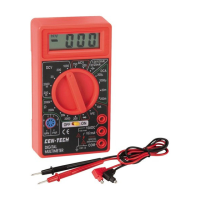SKU 98025 For technical questions, please call 1-800-444-3353. Page 6
COM (Bottom) Jack. Switch the Multi-
meter ON.
Carefully touch the exposed conduc-5.
tors with the tips of the probes to
measure the amperage.
Note: Amperage is always tested in series
with the circuit under test.
Read measurement. 6.
If the reading is less than .2 AMPs, 7.
switch the red lead to the VWmA
(Center) Jack and set the Range Se-
lector Switch to the 200 mA setting.
When testing is complete, remove 8.
Test Leads and store with multimeter.
Resistance Measurements
Measure circuit resistance up to 1.
2000K Ohms.
Warning: Never measure resistance 2.
on a circuit with voltage running
through it.
Turn the Range Selector Switch to the 3.
200 W position.
Plug the red Test Lead into the VWmA 4.
(Center) Jack. Plug the black Test
Lead into the Com (Bottom) Jack.
Switch the Multimeter ON.
Short the Test Leads together. The 5.
meter should read “0” Ohms.
Touch the exposed conductors with 6.
the tips of the Test Leads.
Read measurement.7.
If the reading is “1”, set the Range 8.
Selector Switch to the next higher
Ohm (W) position.
Transistor (hFE) Measurements
Test transistors to ensure proper 1.
function.
Turn the Range Selector Switch to the 2.
hFE position.
Switch the Multimeter ON.3.
Insert the transistor pins into the 4.
appropriate hFE jack (NPN or PNP)
according to the EBC (Emitter, Base,
Collector) sequence.
The meter will show the approximate 5.
hFE value.
Diode Measurement
Test the voltage drop in diodes.1.
Turn the Range Selector Switch to the 2.
Diode ( ) position.
Plug the red Test Lead into the VWmA 3.
(Center) Jack. Plug the black Test
Lead into the Com (Bottom) Jack.
Switch the Multimeter ON.
Connect the red probe to the anode 4.
of the diode and the black to the
cathode.
The approximate forward voltage drop 5.
of the diode will be displayed in mV.
If the connection is reversed only “1”
will be shown.
Battery Charge Measurement
Test the amount of charge left in bat-1.
teries.
NOTE: This setting is for testing the
charge of small 9V or 1.5V batteries
only. Never use this setting to test au-
tomotive or lead-acid batteries. The
high current could cause damage
to the meter and/or cause severe
personal injury. Use the appropri-
ate DC Voltage setting to test the
open circuit voltage of such batteries
instead.
Turn the Range Selector Switch to the 2.
Battery ( ) position.

